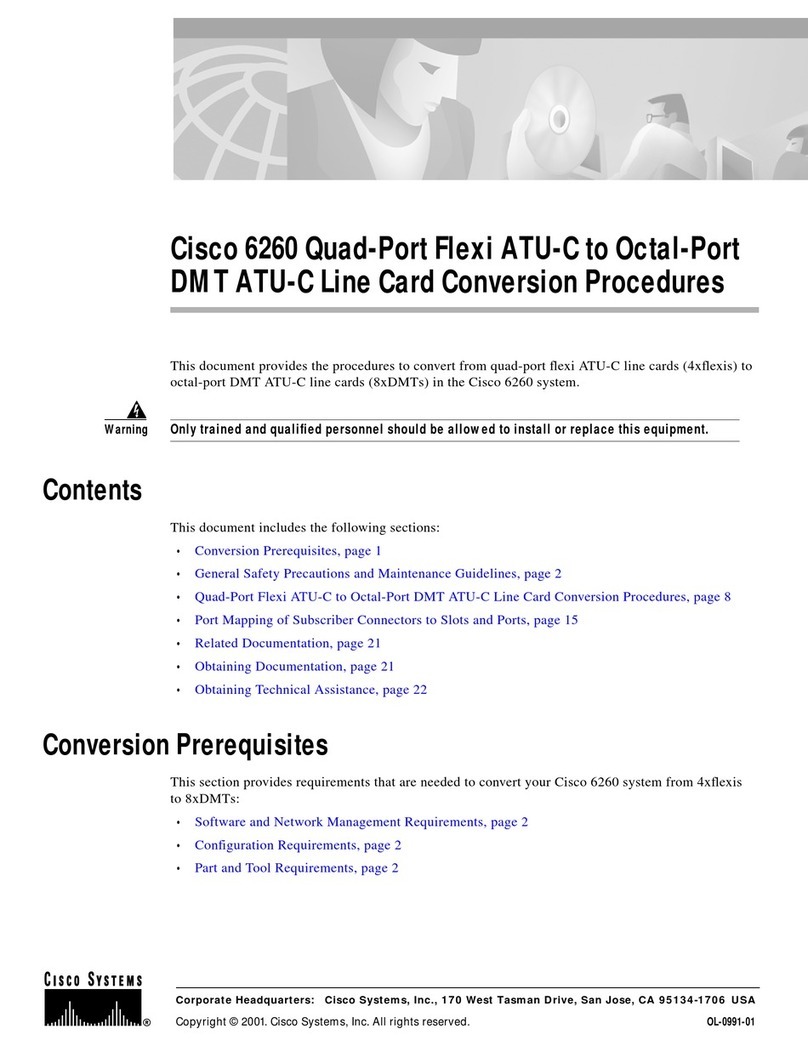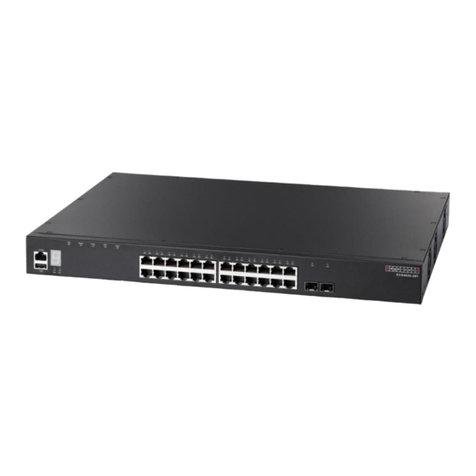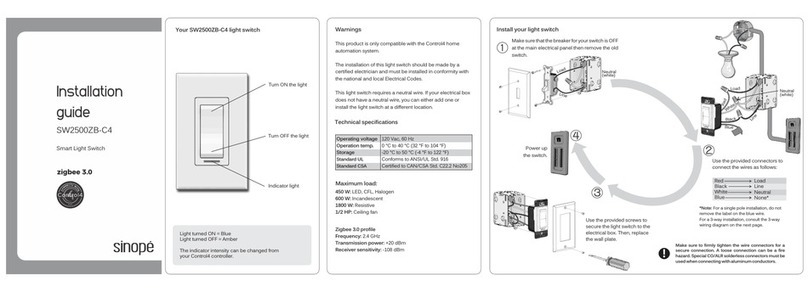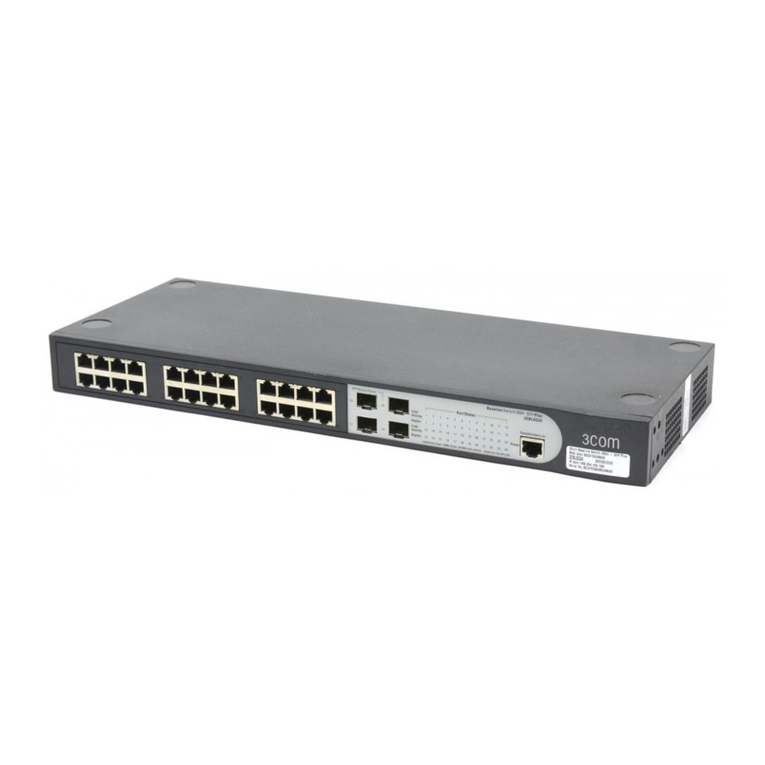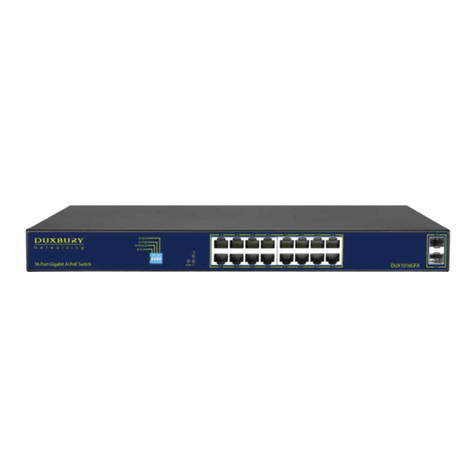Barox RY-LGSO25-24 User manual

barox Kommunikation
RY-LGSO25-24
User’s Manual

barox Kommunikation
Publication date: Sept., 2015
Revision A2
i
RY-LGSO25-24
User's Manual
24-Port L2 PoE Plus Managed Switch
Release 6.38

barox Kommunikation
Publication date: Sept., 2015
Revision A2
ii
About This Manual
Copyright The products and programs described in this User’s Manual are licensed
products of Manufacture Technology, This User’s Manual contains proprietary
information protected by copyright, and this User’s Manual and all
accompanying hardware, software and documentation are copyrighted. No
parts of this User’s manual may be copied, photocopied, reproduced,
translated or reduced to any electronic medium or machine-readable from by
any means by electronic or mechanical. Including photocopying, recording, or
information storage and retrieval systems, for any purpose other than the
purchaser’s personal use, and without the prior express written permission of
Manufacture Technology.
.
Purpose This manual gives specific information on how to operate and use the
management functions of the RY-LGSO25-24
Audience The Manual is intended for use by network administrators who are
responsible for operating and maintaining network equipment;
consequently, it assumes a basic working knowledge of general
switch functions, the Internet Protocol (IP), and Simple Network
Management Protocol (SNMP).
CONVENTIONS The following conventions are used throughout this manual to show
information.
WARRANTY See the Customer Support/ Warranty booklet included with the
product. A copy of the specific warranty terms applicable to your
Manufacture products and replacement parts can be obtained from
your Manufacture Sales and Service Office authorized dealer.
Disclaimer Manufacture Technology does not warrant that the hardware will
work properly in all environments and applications, and marks no
warranty and representation, either implied or expressed, with
respect to the quality, performance, merchantability, or fitness for a
particular purpose. Manufacture disclaims liability for any
inaccuracies or omissions that may have occurred. Information in
this User’s Manual is subject to change without notice and does not
represent a commitment on the part of Manufacture. Manufacture
assumes no responsibility for any inaccuracies that may be
contained in this User’s Manual. Manufacture makes no commitment
to update or keep current the information in this User’s Manual, and
reserves the righter to make improvements to this User’s Manual
and /or to the products described in this User’s Manual, at any time
without notice.
FCC Warning This equipment has been tested and found to comply with the limits
for a Class B digital device, pursuant to Part 15 of the FCC Rules.
These limits are designed to provide reasonable protection against
harmful interference when the equipment is operated in a
commercial environment. This equipment generates, uses, and can
radiate radio frequency energy and, if not installed and used in

barox Kommunikation
Publication date: Sept., 2015
Revision A2
iii
accordance with the Instruction manual, may cause harmful
interference to radio communications.
FCC Caution To assure continued compliance (example-use only shielded
interface cables when connection to computer or peripheral devices).
Any changes or modifications not expressly approved by the party
responsible for compliance could void the user’s authority to operate
the equipment. This device complies with Part 15 of the FCC Rules.
Operation is subject to the Following two conditions: (1) This device
may not cause harmful interference, and (2) this device must accept
any interference received, including interference that may cause
undesired operation.
CE mark
Warning This is a Class B device, In a domestic environment, this product may
cause radio interference, in which case the user may be required to
take adequate measures.
NOTE:Emphasizes important information or calls your
attention to related features or instructions.
W
ARNING
:
Alerts you to a potential hazard that could cause
personal injury.
C
AUTION
:
Alerts you to a potential hazard that could cause loss
of data, or damage the system or equipment.

barox Kommunikation
Publication date: Sept., 2015
Revision A2
iv
Table of Contents
Revision History ................................................................................................................................................ ix
INTRODUCTION........................................................................................................................... 1
CHAPTER 1 OPERATION OF WEB-BASED MANAGEMENT .....................................................2
CHAPTER 2 SYSTEM CONFIGURATION..................................................................................6
2-1 System .......................................................................................................................................................6
2-1.1 Information ............................................................................................................................................... 6
2-1.2 IP ............................................................................................................................................................... 7
2-1.3 NTP ......................................................................................................................................................... 10
2-1.4 Time ........................................................................................................................................................ 11
2-1.5 Log .......................................................................................................................................................... 14
2-2 Green Ethernet ........................................................................................................................................15
2-3 Ports Configuration ..................................................................................................................................18
2-3.1 Ports........................................................................................................................................................ 18
2-3.2 Ports Description .................................................................................................................................... 21
2-4DHCP ........................................................................................................................................................22
2-4.1 Server...................................................................................................................................................... 22
2-4.1.1 Mode............................................................................................................................................. 22
2-4.1.2 Excluded IP.................................................................................................................................. 24
2-4.1.3 Pool............................................................................................................................................... 25
2-4.2 Snooping ................................................................................................................................................. 27
2-4.3 Relay ....................................................................................................................................................... 29
2-5 Security....................................................................................................................................................31
2-5.1 Switch ..................................................................................................................................................... 31
2-5.1.1 Users............................................................................................................................................. 31
2-5.1.2 Privilege Level............................................................................................................................. 33
2-5.1.3 Authentication Method................................................................................................................ 35
2-5.1.4 SSH............................................................................................................................................... 36
2-5.1.5 HTTPs........................................................................................................................................... 37
2-5.1.6 Access Management.................................................................................................................. 38
2-5.1.7 SNMP............................................................................................................................................ 40
2-5.1.8 RMON........................................................................................................................................... 55
2-5.2 Network .................................................................................................................................................. 62
2-5.2.1 Limit Control................................................................................................................................. 62
2-5.2.2 NAS............................................................................................................................................... 66
2-5.2.3 ACL ............................................................................................................................................... 74
2-5.2.4 IP Source Guard ......................................................................................................................... 83
2-5.2.5 ARP Inspection............................................................................................................................ 87
2-5.3 AAA ......................................................................................................................................................... 95
2-5.3.1 RADIUS........................................................................................................................................ 95
2-5.3.2 TACACS+..................................................................................................................................... 98
2-6 Aggregation ...........................................................................................................................................100
2-6.1 Static ..................................................................................................................................................... 100
2-6.2 LACP ...................................................................................................................................................... 103
2-7 Loop Protection .....................................................................................................................................105

barox Kommunikation
Publication date: Sept., 2015
Revision A2
v
2-8 Spanning Tree ........................................................................................................................................107
2-8.1 Bridge Setting........................................................................................................................................ 107
2-8.2 MSTI Mapping....................................................................................................................................... 110
2-8.3 MSTI Priorities....................................................................................................................................... 112
2-8.4 CIST Ports .............................................................................................................................................. 113
2-8.5 MSTI Ports............................................................................................................................................. 116
2-9 IPMC Profile ...........................................................................................................................................118
2-9.1 Profile Table .......................................................................................................................................... 118
2-9.1.1 IPMC Profile Rule Settings Table ........................................................................................... 119
2-9.2 Address Entry........................................................................................................................................ 121
2-10MVR......................................................................................................................................................123
2-11 IPMC ....................................................................................................................................................126
2-11.1 IGMP Snooping ................................................................................................................................... 126
2-11.1.1 Basic Configuration................................................................................................................. 126
2-11.1.2 VLAN Configuration................................................................................................................ 128
2-11.1.3 Port Filtering Profile................................................................................................................ 130
2-11.2 MLD Snooping..................................................................................................................................... 132
2-11.2.1 Basic Configuration................................................................................................................. 132
2-11.2.2 VLAN Configuration................................................................................................................ 135
2-11.2.3 Port Group Filtering ................................................................................................................ 137
2-12 LLDP.....................................................................................................................................................138
2-12.1 LLDP Configuration ............................................................................................................................. 138
2-12.2 LLDP-MED Configuration .................................................................................................................... 141
2-13 MAC Table............................................................................................................................................148
2-14 VLANs ..................................................................................................................................................151
2-15 Private VLANs ......................................................................................................................................155
2-15.1 VLAN Membership.............................................................................................................................. 155
2-15.2 Port Isolation....................................................................................................................................... 157
2-16 VCL.......................................................................................................................................................158
2-16.1 MAC-based VLAN................................................................................................................................ 158
2-16.2 Protocol -based VLAN ......................................................................................................................... 160
2-16.2.1 Protocol to Group.................................................................................................................... 160
2-16.2.2 Group to VLAN........................................................................................................................ 162
2-16.3 IP Subnet-based VLAN ........................................................................................................................ 163
2-17 VOICE VLAN .........................................................................................................................................165
2-17.1 Configuration ...................................................................................................................................... 165
2-17.2 OUI...................................................................................................................................................... 167
2-18 QoS ......................................................................................................................................................168
2-18.1 Port Classification ............................................................................................................................... 168
2-18.2 Port Policing ........................................................................................................................................ 171
2-18.4 Port Schedulers................................................................................................................................... 172
2-18.5 Port Shaping........................................................................................................................................ 175
2-18.6 Port Tag Remarking ............................................................................................................................. 178
2-18.7 Port DSCP ............................................................................................................................................ 181
2-18.8 DSCP-Based QoS ................................................................................................................................. 183
2-18.9 DSCP Translation ................................................................................................................................. 185
2-18.10 DSCP Classification............................................................................................................................ 187
2-18.11 QoS Control List Configuration ......................................................................................................... 189
2-18.12 Storm Control ................................................................................................................................... 193
2-18.13 WRED ................................................................................................................................................ 195

barox Kommunikation
Publication date: Sept., 2015
Revision A2
vi
2-19 Mirror ..................................................................................................................................................197
2-20 UPnP ....................................................................................................................................................199
2-21. GVRP...................................................................................................................................................201
2-21.1 Global Config ...................................................................................................................................... 201
2-21.2 Port Config .......................................................................................................................................... 203
2-22. sFlow ..................................................................................................................................................204
2-23 Switch2go.........................................................................................................................................207
2-23.1 Switch2go setting............................................................................................................................ 207
2-23.2 User Link Management................................................................................................................... 208
2-23.3 Port Name Service........................................................................................................................... 210
CHAPTER 3. MONITOR .......................................................................................................211
3-1 System ...................................................................................................................................................211
3-1.1 Information ........................................................................................................................................... 211
3-1.3 IP Status ................................................................................................................................................ 213
3-1.4 Log ........................................................................................................................................................ 215
3-1.5 Detailed Log .......................................................................................................................................... 217
3-2 Green Ethernet ......................................................................................................................................218
3-2.1 Port Power Savings ............................................................................................................................... 218
3-3 Ports ......................................................................................................................................................219
3-3.1 Traffic Overview .................................................................................................................................... 219
3-3.2 Qos Statistics......................................................................................................................................... 221
3-3.3 QCL Status............................................................................................................................................. 222
3-3.4 Detailed Statistics.................................................................................................................................. 224
3-4 DHCP......................................................................................................................................................228
3-4.1 Server.................................................................................................................................................... 228
3-4.1.1 Statistics..................................................................................................................................... 228
3-4.1.2 Binding........................................................................................................................................ 229
3-4.1.3 Declined IP................................................................................................................................. 230
3-4.2 Snooping Table...................................................................................................................................... 231
3-4.3 Relay Statistics ...................................................................................................................................... 232
3-4.4 Detailed Statistics.................................................................................................................................. 234
3-5 Security..................................................................................................................................................236
3-5.1 Access Management Statistics.............................................................................................................. 236
3-5.2 Network ................................................................................................................................................ 237
3-5.2.1 Port Security.............................................................................................................................. 237
3-5.2.2 NAS............................................................................................................................................. 241
3-5.2.3 ACL Status................................................................................................................................... 248
3-5.2.4 ARP Inspection.......................................................................................................................... 249
3-5.2.5 IP Source Guard ....................................................................................................................... 250
3-5.3 AAA ....................................................................................................................................................... 252
3-5.3.1 RADIUS Overview .................................................................................................................... 252
3-5.3.2 RADIUS Details......................................................................................................................... 254
3-5.4 Switch ................................................................................................................................................... 259
3-5.4.1 RMON......................................................................................................................................... 259
3-6 LACP.......................................................................................................................................................268
3-6.1 System Status........................................................................................................................................ 268
3-6.2 Port Status ............................................................................................................................................ 269

barox Kommunikation
Publication date: Sept., 2015
Revision A2
vii
3-6.3 Port Statistics ........................................................................................................................................ 271
3-7 Loop Protection .....................................................................................................................................272
3-8 Spanning Tree ........................................................................................................................................273
3-8.1 Bridge Status......................................................................................................................................... 273
3-8.2 Port Status ............................................................................................................................................ 275
3-8.3 Port Statistics ........................................................................................................................................ 276
3-9 MVR.......................................................................................................................................................278
3-9.1 Statistics ................................................................................................................................................ 278
3-9.2 MVR Channels Groups .......................................................................................................................... 279
3-9.3 MVR SFM Information .......................................................................................................................... 281
3-10 IPMC ....................................................................................................................................................283
3-10.1 IGMP Snooping ................................................................................................................................... 283
3-10.1.1 Status........................................................................................................................................ 283
3-10.1.2 Group Information................................................................................................................... 285
3-10.1.3 IPv4 SFM Information ............................................................................................................ 287
3-10.2 MLD Snooping..................................................................................................................................... 289
3-10.2.1 Status........................................................................................................................................ 289
3-10.2.2 Group Information................................................................................................................... 291
3-10.2.3 IPv6 SFM Information ............................................................................................................ 293
3-11 LLDP.....................................................................................................................................................295
3-11.1 Neighbour ........................................................................................................................................... 295
3-11.2 LLDP-MED Neighbour ......................................................................................................................... 297
3-11.3 EEE ...................................................................................................................................................... 300
3-11.4 Port Statistics ...................................................................................................................................... 302
3-12 MAC Table............................................................................................................................................304
3-13 VLANs ..................................................................................................................................................306
3-13.1 VLAN Membership.............................................................................................................................. 306
3-13.2 VLAN Port............................................................................................................................................ 308
3-14 VCL.......................................................................................................................................................310
3-14.1 MAC-based VLAN................................................................................................................................ 310
3-14.2 Protocol-based VLAN .......................................................................................................................... 311
3-14.2.1 Protocol to Group.................................................................................................................... 311
3-14.2.2 Group to VLAN........................................................................................................................ 313
3-14.3 IP Subnet-based VLAN ........................................................................................................................ 314
3-15 sFlow ...................................................................................................................................................315
CHAPTER 4. DIAGNOSTICS ...............................................................................................317
4-1 Ping........................................................................................................................................................317
4-2 Ping6......................................................................................................................................................319
4-3 VeriPHY..................................................................................................................................................321
4-4 Traceroute..............................................................................................................................................322
CHAPTER 5. MAINTENANCE .............................................................................................323
5-1 Restart Device........................................................................................................................................323

barox Kommunikation
Publication date: Sept., 2015
Revision A2
viii
5-2 Factory Defaults .....................................................................................................................................324
5-3 Firmware ...............................................................................................................................................325
5-3.1 Firmware upgrade................................................................................................................................. 325
5-3.2 Firmware Selection ............................................................................................................................... 326
5-4 Configuration .........................................................................................................................................328
5-4.1 Save startup-config ............................................................................................................................... 328
5-4.2 Upload .................................................................................................................................................. 329
5-4.3 Download.............................................................................................................................................. 330
5-4.5 Delete.................................................................................................................................................... 332

barox Kommunikation
Publication date: Sept., 2015
Revision A2
ix
Revision History
Release
Date
Revision
V6.05
12/08//2014
A1
V6.38
09/30/2015
A2

barox Kommunikation
Publication date: Sept., 2015
Revision A2
1
INTRODUCTION
Overview
In this user’s manual, it will not only tell you how to install and connect your network
system but configure and monitor the RY-LGSO25-24 through the web by (RJ-45) serial
interface and Ethernet ports step-by-step. Many explanations in detail of hardware and
software functions are shown as well as the examples of the operation for web-based
interface.
The RY-LGSO25-24 series, the next generation Web managed switches from
Manufacture, is a portfolio of affordable managed switches that provides a reliable
infrastructure for your business network. These switches deliver more intelligent features
you need to improve the availability of your critical business applications, protect your
sensitive information, and optimize your network bandwidth to deliver information and
applications more effectively. It provides the ideal combination of affordability and
capabilities for entry level networking includes small business or enterprise application
and helps you create a more efficient, better-connected workforce.
RY-LGSO25-24 Web Managed Switches provide 24 ports in a single device; the
specification is highlighted as follows.
L2+ features provide better manageability, security, QoS, and performance.
Support IPv4/IPv6 dual stack management
Support SSH/SSL secured management
Support SNMP v1/v2c/v3
Support RMON groups 1,2,3,9
Support sFlow
Support IGMP v1/v2/v3 Snooping
Support MLD v1/v2 Snooping
Support RADIUS and TACACS+ authentication
Support IP Source Guard
Support DHCP Relay (Option 82)
Support DHCP Snooping
Support ACL and QCL for traffic filtering
Support 802.1d(STP), 802.1w(RSTP) and 802.1s(MSTP)
Support LACP and static link aggregation
Support Q-in-Q double tag VLAN
Support GVRP dynamic VLAN
Overview of this user’s manual
Chapter 1 “Operation of Web-based Management”
Chapter 2 “System Configuration”
Chapter 3 “Configuration”
Chapter 4 “Security”
Chapter 5 “Maintenance”

barox Kommunikation
Publication date: Sept., 2015
Revision A2
2
Chapter 1 Operation of Web-based Management
Initial
Configuration This chapter instructs you how to configure and manage the
RY-LGSO25-24 through the web user interface. With this facility, you can
easily access and monitor through any one port of the switch all the status of
the switch, including MIBs status, each port activity, Spanning tree status,
port aggregation status, multicast traffic, VLAN and priority status, even
illegal access record and so on.
The default values of the RY-LGSO25-24 are listed in the table below:
IP Address
192.168.1.1
Subnet Mask
255.255.255.0
Default
Gateway
192.168.1.254
Username
admin
Password
admin
After the RY-LGSO25-24 has been finished configuration the it interface, you
can browse it. For instance, type http://192.168.1.1 in the address row in
a browser, it will show the following screen and ask you inputting username
and password in order to login and access authentication.
The default username is “admin”and password is “admin”. For the first
time to use, please enter the default username and password, and then click
the <Login> button. The login process now is completed. In this login menu,
you have to input the complete username and password respectively, the
RY-LGSO25-24 will not give you a shortcut to username automatically. This
looks inconvenient, but safer.
In the RY-LGSO25-24, allowed two or more users using administrator’s
identity to manage this switch, which administrator to do the last setting, it
will be an available configuration to effect the system.
NOTE:
When you login the Switch WEB/CLI to manager. You must first type
the Username of the admin. Password was blank, so when you
type after the end Username, please press enter. Management page
to enter WEB/CLI.
When you login RY-LGSO25-24 series switch Web UI management,
you can use both ipv4 ipv6 login to manage
To optimize the display effect, we recommend you use Microsoft IE
6.0 above, Netscape V7.1 above or FireFox V1.00 above and have
the resolution 1024x768. The switch supported neutral web browser
interface

Publication date: Sept., 2015
Revision A2
5
NOTE:
AS RY-LGSO25-24 the function enable dhcp, so If you do not have
DHCP server to provide ip addresses to the switch, the Switch
default ip 192.168.1.1
Figure 1 The login page

barox Kommunikation
Publication date: Sept., 2015
Revision A2
6
Chapter 2 System Configuration
This chapter describes the entire basic configuration tasks which includes the System
Information and any manage of the Switch (e.g. Time, Account, IP, Syslog and NTP.)
2-1 System
You can identify the system by configuring the contact information, name, and location of the
switch.
2-1.1 Information
The switch system’s contact information is provided here.
Web interface
To configure System Information in the web interface:
1. Click Configuration, System, and Information.
2. Write System Contact, System Name, System Location information in this page.
3. Click Apply
Figure 2-1.1: System Information
Parameter description:
System Contact:
The textual identification of the contact person for this managed node, together
with information on how to contact this person. The allowed string length is 0 to
128, and the allowed content is the ASCII characters from 32 to 126.
System name:
An administratively assigned name for this managed node. By convention, this is
the node's fully-qualified domain name. A domain name is a text string drawn
from the alphabet (A-Za-z), digits (0-9), minus sign (-). No space characters are
permitted as part of a name. The first character must be an alpha character. And
the first or last character must not be a minus sign. The allowed string length is 0
to 128.
System Location:
The physical location of this node(e.g., telephone closet, 3rd floor). The allowed
string length is 0 to 128, and the allowed content is the ASCII characters from 32
to 126.

barox Kommunikation
Publication date: Sept., 2015
Revision A2
7
2-1.2 IP
The IPv4 address for the switch could be obtained via DHCP Server for VLAN 1. To manually
configure an address, you need to change the switch's default settings to values that are
compatible with your network. You may also need to establish a default gateway between the
switch and management stations that exist on another network segment.
Configure the switch-managed IP information on this page
Configure IP basic settings, control IP interfaces and IP routes.
The maximum number of interfaces supported is 8 and the maximum number of routes is 32.
Web Interface
To configure an IP address in the web interface:
1. Click Configuration, System, IP.
2. Click Add Interface then you can create new Interface on the switch.
3. Click Add Route then you can create new Route on the switch
4. Click Apply
Figure2-1.2: The IP configuration
Parameter description:
IP Configuration
Mode:
Configure whether the IP stack should act as a Host or a Router. In Host mode, IP traffic

barox Kommunikation
Publication date: Sept., 2015
Revision A2
8
between interfaces will not be routed. In Router mode traffic is routed between all
interfaces.
DNS Server
This setting controls the DNS name resolution done by the switch. The following modes are
supported:
From any DHCP interfaces
The first DNS server offered from a DHCP lease to a DHCP-enabled interface will be
used.
No DNS server
No DNS server will be used.
Configured
Explicitly provide the IP address of the DNS Server in dotted decimal notation.
From this DHCP interface
Specify from which DHCP-enabled interface a provided DNS server should be
preferred.
DNS Proxy
When DNS proxy is enabled, system will relay DNS requests to the currently configured
DNS server, and reply as a DNS resolver to the client devices on the network.
IP Interfaces
Delete
Select this option to delete an existing IP interface.
VLAN
The VLAN associated with the IP interface. Only ports in this VLAN will be able to access
the IP interface. This field is only available for input when creating an new interface.
IPv4 DHCP Enabled
Enable the DHCP client by checking this box. If this option is enabled, the system will
configure the IPv4 address and mask of the interface using the DHCP protocol. The DHCP
client will announce the configured System Name as hostname to provide DNS lookup.
IPv4 DHCP Fallback Timeout
The number of seconds for trying to obtain a DHCP lease. After this period expires, a
configured IPv4 address will be used as IPv4 interface address. A value of zero disables
the fallback mechanism, such that DHCP will keep retrying until a valid lease is obtained.
Legal values are 0 to 4294967295 seconds.
IPv4 DHCP Current Lease
For DHCP interfaces with an active lease, this column show the current interface address,
as provided by the DHCP server.
IPv4 Address
The IPv4 address of the interface in dotted decimal notation.
If DHCP is enabled, this field is not used. The field may also be left blank if IPv4 operation
on the interface is not desired.
IPv4 Mask
The IPv4 network mask, in number of bits (prefix length). Valid values are between 0 and 30
bits for a IPv4 address.
If DHCP is enabled, this field is not used. The field may also be left blank if IPv4 operation
on the interface is not desired.
IPv6 Address
The IPv6 address of the interface. A IPv6 address is in 128-bit records represented as eight
fields of up to four hexadecimal digits with a colon separating each field (:). For example,
fe80::215:c5ff:fe03:4dc7. The symbol :: is a special syntax that can be used as a shorthand
way of representing multiple 16-bit groups of contiguous zeros; but it can appear only once.
It can also represent a legally valid IPv4 address. For example, ::192.1.2.34.
The field may be left blank if IPv6 operation on the interface is not desired.

barox Kommunikation
Publication date: Sept., 2015
Revision A2
9
IPv6 Mask
The IPv6 network mask, in number of bits (prefix length). Valid values are between 1 and
128 bits for a IPv6 address.
The field may be left blank if IPv6 operation on the interface is not desired.
IP Routes
Delete
Select this option to delete an existing IP route.
Network
The destination IP network or host address of this route. Valid format is dotted decimal
notationor a valid IPv6 notation. A default route can use the value 0.0.0.0or IPv6 :: notation.
Mask Length
The destination IP network or host mask, in number of bits (prefix length). It defines how
much of a network address that must match, in order to qualify for this route. Valid values
are between 0 and 32 bits respectively 128 for IPv6 routes. Only a default route will have a
mask length of 0 (as it will match anything).
Gateway
The IP address of the IP gateway. Valid format is dotted decimal notationor a valid IPv6
notation. Gateway and Network must be of the same type.
Next Hop VLAN (Only for IPv6)
The VLAN ID (VID) of the specific IPv6 interface associated with the gateway.
The given VID ranges from 1 to 4094 and will be effective only when the corresponding
IPv6 interface is valid.
If the IPv6 gateway address is link-local, it must specify the next hop VLAN for the gateway.
If the IPv6 gateway address is not link-local, system ignores the next hop VLAN for the
gateway.
Buttons
Add Interface:
Click to add a new IP interface. Amaximum of 8 interfaces is supported.
Add Route:
Click to add a new IP route. Amaximum of 32 routes is supported.
Apply:
Click to save changes.
Reset:
Click to undo any changes made locally and revert to previously saved values.

barox Kommunikation
Publication date: Sept., 2015
Revision A2
10
2-1.3 NTP
NTP is Network Time Protocol and is used to sync the network time based Greenwich Mean
Time (GMT). If use the NTP mode and select a built-in NTP time server or manually specify an
user-defined NTP server as well as Time Zone, the switch will sync the time in a short after
pressing <Apply> button. Though it synchronizes the time automatically, NTP does not update
the time periodically without user’s processing.
Time Zone is an offset time off GMT. You have to select the time zone first and then perform
time sync via NTP because the switch will combine this time zone offset and updated NTP time
to come out the local time, otherwise, you will not able to get the correct time. The switch
supports configurable time zone from –12 to +13 step 1 hour.
Default Time zone: +8 Hrs.
Web Interface
To configure NTP in the web interface:
1. Click Configuration, System, NTP.
2. Specify the Time parameter in manual parameters.
3. Click Apply.
Figure 2-1.3: The NTP configuration
Parameter description:
Mode :
Indicates the NTP mode operation. Possible modes are:
Enabled: Enable NTP client mode operation.
Disabled: Disable NTP client mode operation.
Server 1 to 5 :
Provide the NTP IPv4 or IPv6 address of this switch. IPv6 address is in 128-bit
records represented as eight fields of up to four hexadecimal digits with a colon
separating each field (:). For example, 'fe80::215:c5ff:fe03:4dc7'. The symbol
'::' is a special syntax that can be used as a shorthand way of representing
multiple 16-bit groups of contiguous zeros; but it can only appear once. It can
also represent a legally valid IPv4 address. For example, '::192.1.2.34'.
Buttons

barox Kommunikation
Publication date: Sept., 2015
Revision A2
11
These buttons are displayed on the NTP page:
Apply –Click to save changes.
Reset - Click to undo any changes made locally and revert to previously saved
values.

Publication date: Sept., 2015
Revision A2
11
2-1.4 Time
The switch provides manual and automatic ways to set the system time via NTP. Manual
setting is simple and you just input “Year”, “Month”, “Day”, “Hour” and “Minute” within the valid
value range indicated in each item.
Web Interface
To configure Time in the web interface:
1. Click Configuration, System and Time
2. Specify the Time parameter.
3. Click Apply.
Figure 2-1.4: The time configuration
Table of contents
Other Barox Switch manuals
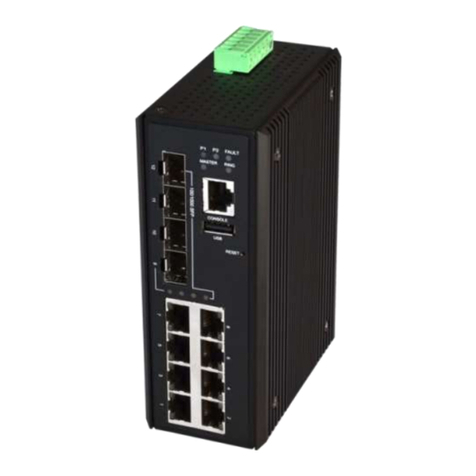
Barox
Barox LT-804GBTME User manual

Barox
Barox PC-PIGE500-GBTE User manual

Barox
Barox L Series User manual
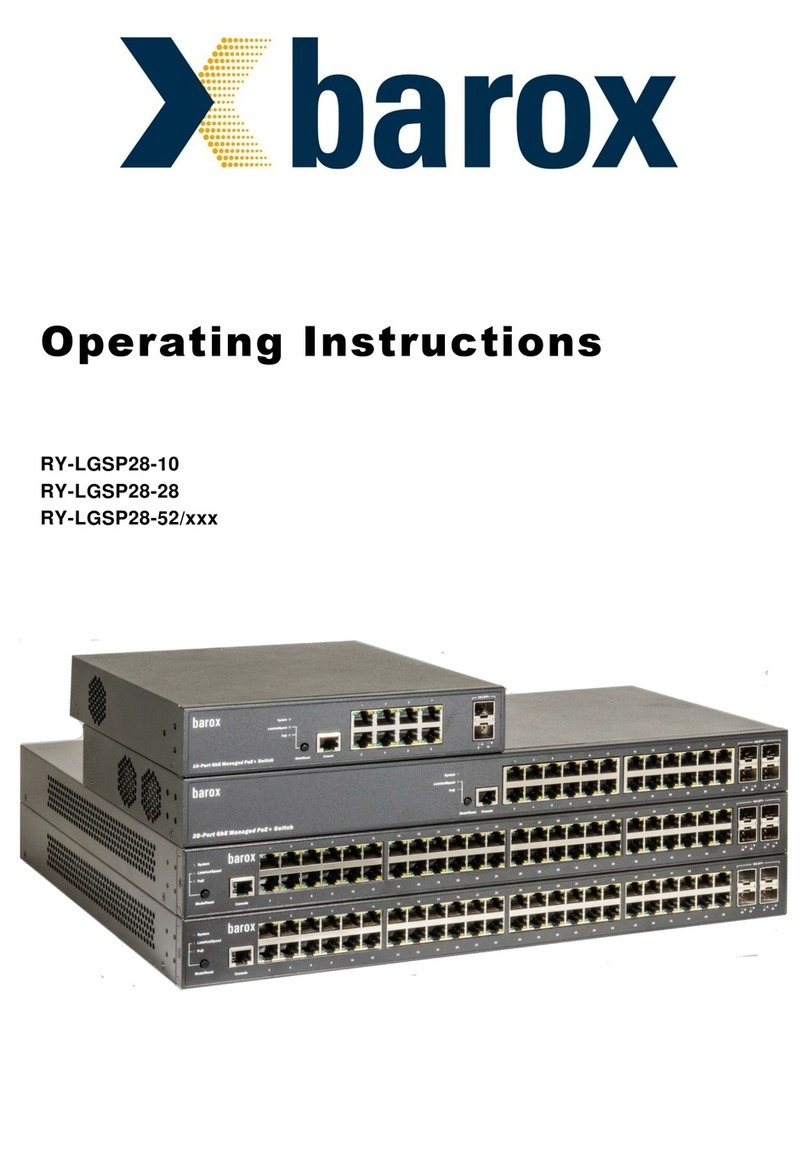
Barox
Barox RY-LGSP28-52 Series User manual
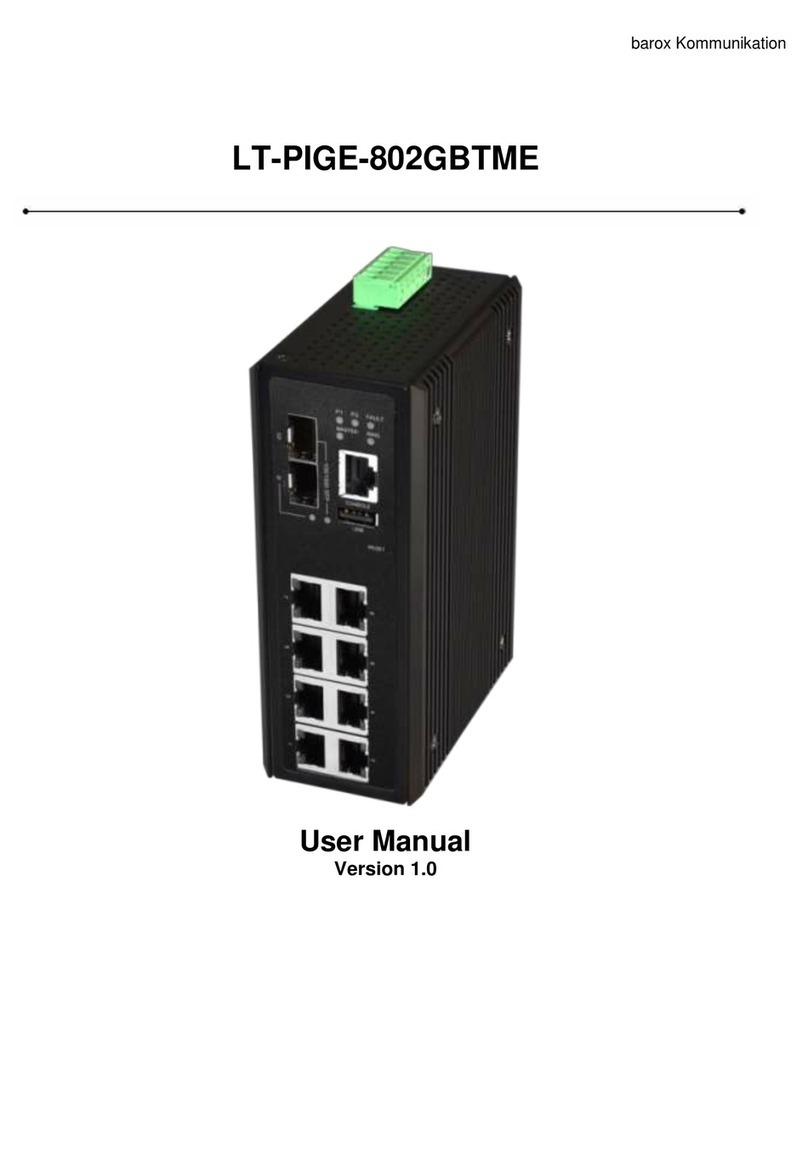
Barox
Barox LT-PIGE-802GBTME User manual

Barox
Barox PC-IA100 Series User manual
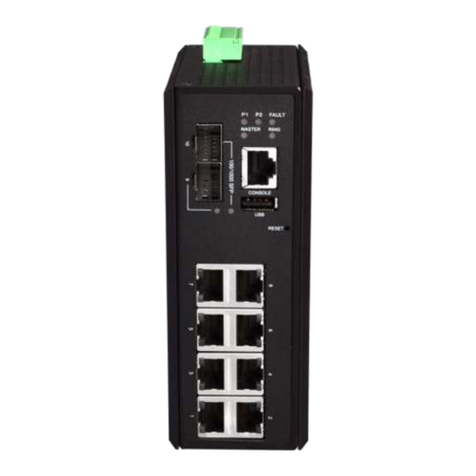
Barox
Barox LT-802GBTME User manual
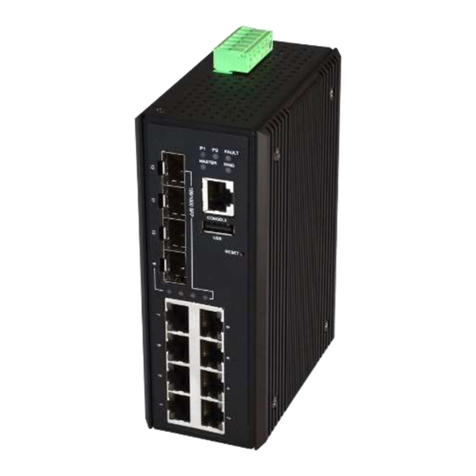
Barox
Barox LT-PIGE-804GBTME Series User manual
Popular Switch manuals by other brands
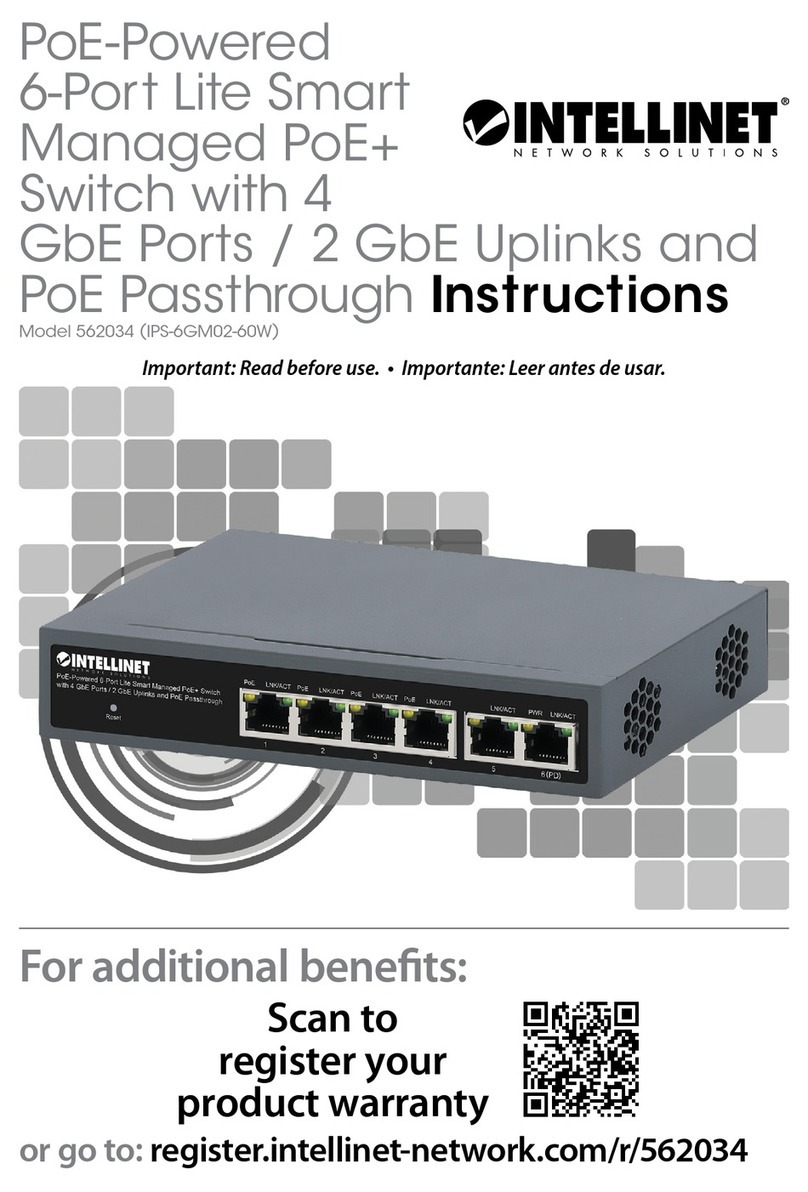
Intellinet
Intellinet IPS-6GM02-60W instructions
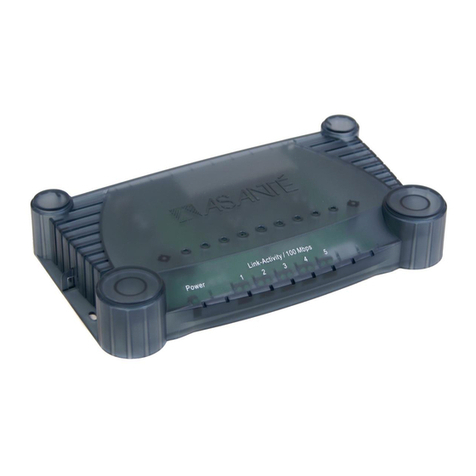
Asante
Asante FriendlyNET Wireless USB Adapter Quick installation guide
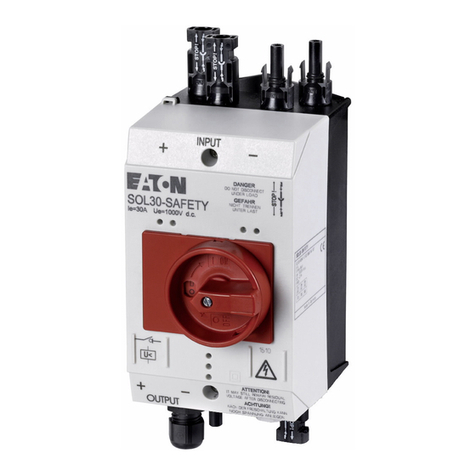
Eaton
Eaton SOL30-SAFETY/2M Series Instruction leaflet
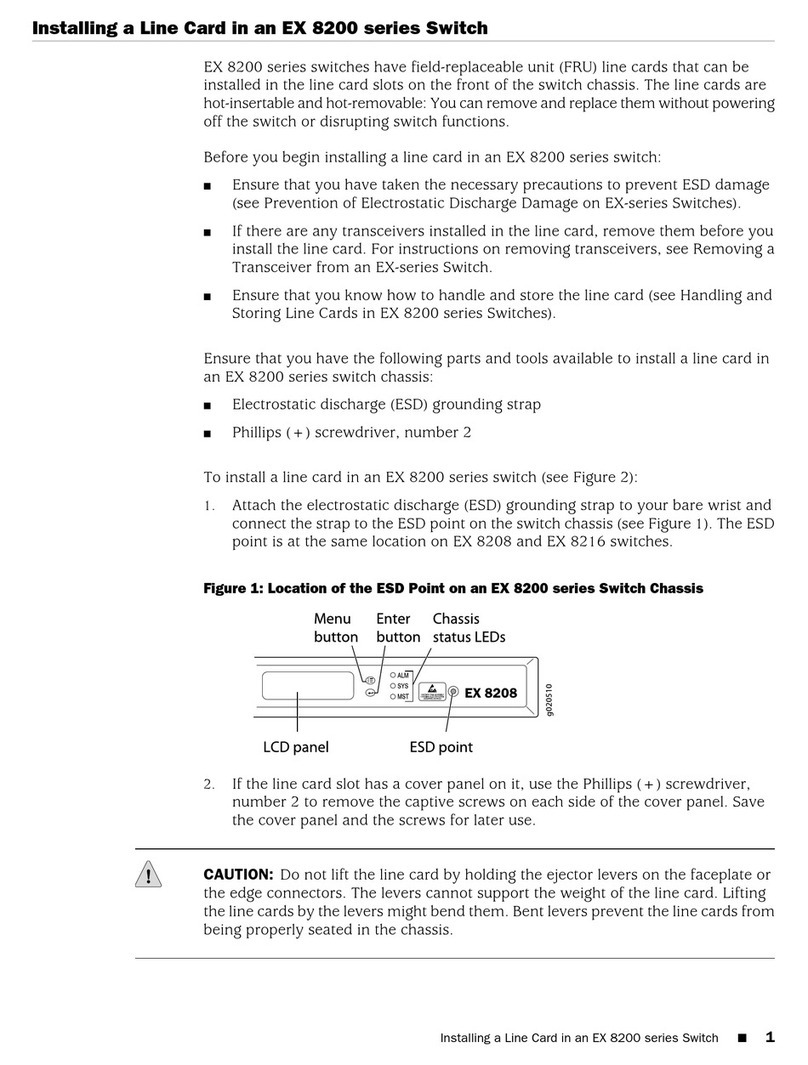
Juniper
Juniper EX8200 Series Installing manual

Allied Telesis
Allied Telesis AT-8100S/16F8-SC Specifications
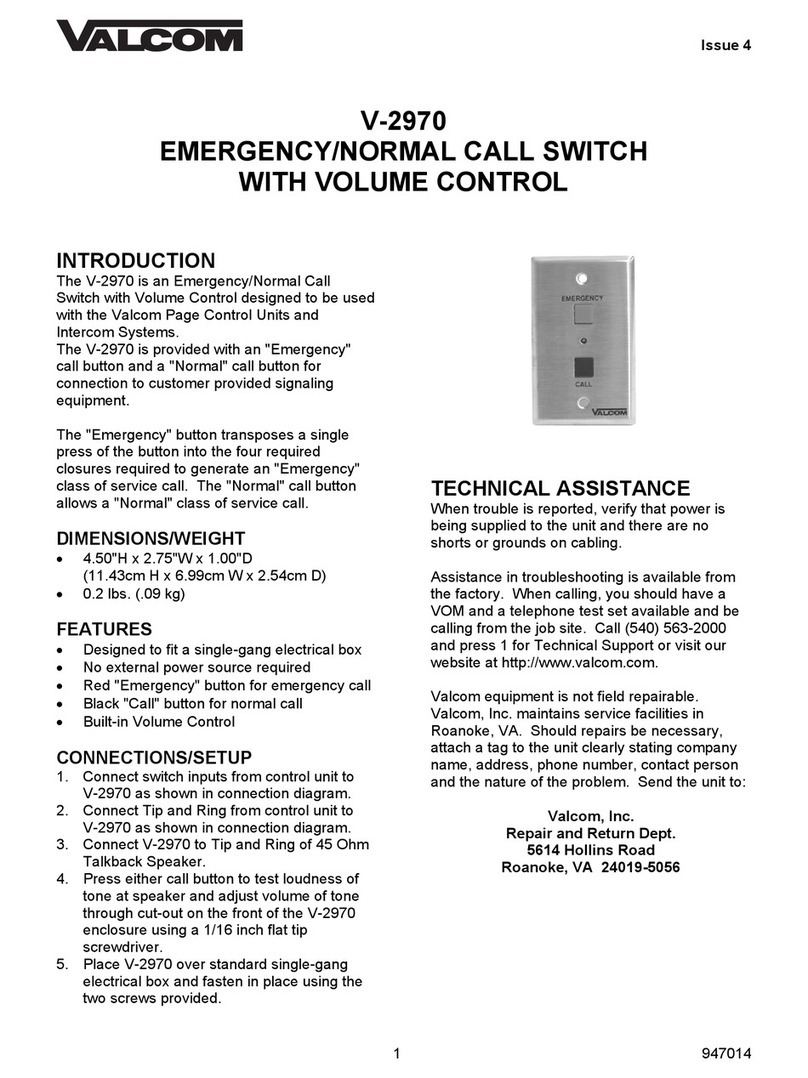
Valcom
Valcom V-2970 instruction manual



